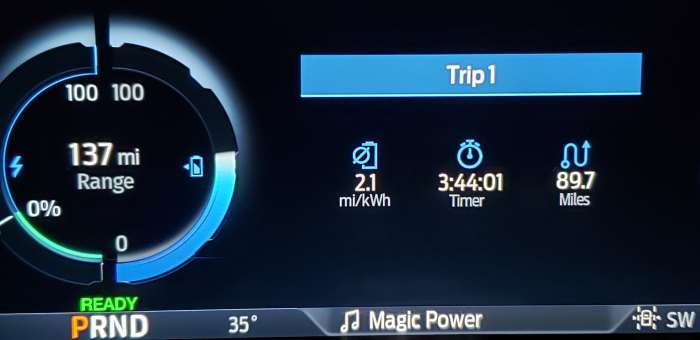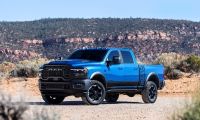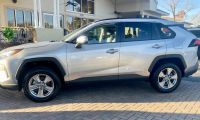One of the main selling features electric vehicles were supposed to have is a lower cost of energy. After all, we know that gas prices are crazy and that battery-electric vehicles must be the cheaper way to go.
Actually, that is not correct in all areas. Even in some EV-friendly areas. The truth is, in some places that EVs are warmly embraced and supported with favorable policies, they are a higher-cost vehicle option compared to hybrids and in some cases, conventional vehicles. This can be true even after government price supports and other factors are considered.
Before we begin, be advised that our story here focuses on one place we often test EVs, Massachusetts. This state is ahead of the curve in America. We moved quickly to push carbon out of the power grid. We also decommissioned our nuclear power plants and have maxed out the inexpensive hydro power we import. So, for much of the state, what is left is natural gas and renewables like cogeneration from trash-burning plants. Your state may have expensive gasoline and inexpensive electricity. If that is the case, the example we provide may not apply to you. Also, off-peak EV charging at discounted rates is a thing in many places. Utilities allow EV owners to charge at night at a lower cost per kWh than they pay during high-usage daylight hours. These programs can work really well if your local utility offers it, if you have the right charger to comply with the program, and if the reduced rate is so low that buying discount power isn't a better option.
We spoke to Marty J. Günsberg, a member of Ford's Model e Communications team. Mr. Günsberg told us, "Ford has pilot programs underway with many utilities across the U.S. right now that incentivize our EV customers to charge at night when energy is more widely available and significantly cheaper for utilities, which is allowing our customers in many regions to charge for less." Ford is also actively working with home solar-power companies to offer Ford customers home solar at attractive rates. This is just one way to affordably and cleanly charge the Ford F-150 Lightning.
We have had the pleasure and privilege to test the Ford F-150 Lightning in multiple trims on many occasions. In total, we have had over three weeks to experience the truck. It is a fantastic vehicle. By far the most refined and enjoyable to drive pickup truck on the market based on our testing. It’s clear that Ford is the green truck leader in America by a country mile, offering electrified trucks starting with the $23K Maverick Hybrid, stepping up to the F-150 Hybrid, and ending with the top-trim Lightning, which is around $100K. Those who wish to reduce their carbon footprint and still drive a truck need only look to Ford, regardless of their new vehicle budget. 
How To Calculate Cost Per Mile of an EV Here is how we calculated the cost per mile to power the Ford F-150 Lightning and the Ford F-150 Hybrid 4X4. The Lightning displays the energy used in miles traveled per kWh used. During our use mainly on suburban roads with no energy-sapping miles covered, our energy usage observed was 2.1 miles traveled per kWh consumed. It is displayed as 2.1m/kWh. This energy rate was recorded during “sedate and mature” driving. Specifically not acceleration testing or spirited driving. At my home in Metro Boston, I pay a discounted rate of $0.34/kWh for energy. In other words, 34 cents per kWh. This is the lowest rate offered in my billing area. We chose the energy provider from a list of discounted providers. This is lower in cost than the rate the default company that delivers it charges (Eversource). A rate of use of 2.1m/kWh with a cost of 34 cents per kWh equals a cost per mile of 16.2 cents. This cost does not include charging losses (therefore, we are being as favorable to the Lightning as we can be).
Calculating the Cost Per Mile of a Hybrid To calculate the cost per mile of the Ford F-150 Hybrid 4X4, we turned to the EPA-Estimated Combined Fuel Economy. The EPA lists the value as 23 MPG. FYI, the City, Highway, and Combined value for the F-150 Hybrid is the same. Not that unusual for hybrids. In my state, the average cost of fuel is $3.29 on March 16th, 2023. This is according to AAA. In my town, gasoline costs much less, but let’s use the high number so that we don’t exaggerate the hybrid’s advantage. To obtain our cost per mile, we multiply 329 cents/gallon by 1 Gallon/23 miles. The resulting cost per mile is 14.3 cents per mile.
Use America’s national average for gasoline, and the cost per mile is 15 cents. As you can see, the Hybrid 4X4 version of the Ford F-150 has a 12% lower cost per mile of energy than the fully-electric F-150 Lightning. One reason the Hybrid F-150 can compete with the battery-electric Lighting in terms of energy cost per mile is that the Hybrid has brake-energy regeneration, just like the Lightning does. The Hybrid powers itself, in part, using an electric motor supplied by a battery. However, the hybrid doesn’t need to be plugged in to do that. It gets its electricity by capturing power during deceleration.
Many EVs We Test Have a Higher Cost Per Mile Than Gas-Only Vehicles It is not uncommon for EVs to have a higher cost per mile for energy than hybrids. In our recent tests of the Chevrolet Bolt, we did the math and found that the Prius offered a much lower cost per mile. Roughly half that of the fully-electric Bolt. We have compared similar model hybrids to battery-electric vehicles many times over the past year with the same results. Battery electric is not the least expensive powertrain option in EV-friendly Massachusetts. It trails hybrid-electric, and in some cases, a similarly-sized conventional gas-powered car is even lower in energy cost per mile than a battery-electric vehicle.
Do Not Misunderstand the Point Here Please don’t take this story as meaning the Ford F-150 Lighting isn’t a fantastic truck. It is amazing. Its power, torque, low noise levels, and many other attributes are big pulses. However, like many other BEVs, it does not offer the lowest cost per mile for energy in its vehicle type. And like the Lighting, the Hybrid F-150 can power a job site or a campsite. And the F-150 Hybrid 4X4 can smoke a lot of sporty cars in a stoplight sprint.
How We Made This Comparison More Than Fair In our comparison of costs, we purposely avoided highway driving with the Lightning. The reason we did so is that on the highway, battery-electric vehicles use much more energy than they do when used around town. We also didn’t use our actual (lower) cost for gasoline. Instead, we used the much higher cost which is the overall average for our state. We did these things to ensure the battery-electric vehicle had the best chance of having a favorable outcome. Still, the Hybrid came out on top. With Ford making both of these “4X4” trucks, it is as close of a comparison as we could possibly put together. At the time of our most recent test, the temperature ranged from the low 30s to the mid-50s (F).
EVs Don’t Always Save Owners Money Battery-electric vehicles offer buyers many things. These include local-emissions-free driving and a very satisfying driving experience. However, the up-front costs of BEVs are higher than other available options. We priced out an F-150 Lariat 4X4 Hybrid with zero options and came up with $63,320. We did the same for the F-150 Lighting Lariat (standard range, which is the least expensive) with zero options and came up with a price of $77,514. With a lower up-front cost and a lower cost for energy, the Hybrid F-150 is a good illustration that BEVs may not be the most economical option. What about maintenance costs? Both hybrids and BEVs offer lower brake costs due to regenerative braking. Higher tire costs for EVs negate much of the maintenance savings they offer compared to hybrids. Ford now offers truck buyers hoping to reduce their carbon footprint multiple great options. No other brand is even close to Ford in this regard. Tell us in the comments below what you think of our comparison of these two Ford trucks’ cost for energy.
Image of Ford F-150 Lightning charging on Lectron V-Box by John Goreham.
John Goreham is an experienced New England Motor Press Association member and expert vehicle tester. John completed an engineering program with a focus on electric vehicles, followed by two decades of work in high-tech, biopharma, and the automotive supply chain before becoming a news contributor. In addition to his ten years of work at Torque News, John has published thousands of articles and reviews at American news outlets. He is known for offering unfiltered opinions on vehicle topics. You can follow John on Twitter, and TikTok @ToknCars, and view his credentials at Linkedin Note: Additional content was added to this story shortly after its publication.













Comments
This is a fair call, and
Permalink
This is a fair call, and unbiased analysis. But I am surprised at your home electricity costs. We have very expensive electricity costs in CA, and peak use rate is $0.54/kW, but the Off-peak rate is $0.17, which is half your cost. Most all EVs have built-in timers for their onboard chargers to charge between 12AM and 7AM, and most utility companies have special EV rate plans that provide much cheaper, Off-peak EV charging. So it costs me about $2 in electricity to drive 40 miles in my Cadillac ELR Plug-in hybrid, whereas without charging the traction battery it gets about 40MPG, so on gas alone, each gallon costs me $5. So the Cadillac is very efficient compared to the F150 in EV or hybrid form, as you would expect. But I am hoping to get an Aptera early next year, which potentially can drive those same 40 miles for free, just off the power of the sun. Realistically, in an imperfect world, if I get half the rated mileage from the solar, and half the 10mi/kWh that the Aptera is supposed to achieve optimally, it will still cost me only 34 cents to drive the same 40 miles.
I'm only not surprised
Permalink
In reply to This is a fair call, and by DeanMcManis (not verified)
I'm only not surprised because I've been following the change in how New England generates power. In my local area, we moved off coal early. Also have been taking offline the nukes. So that really only leaves natural gas to make up list gigawatts. Solar is not an option for us. $35K after incentives, and we plan only to stay 6 years here. Our three realtors are in agreement that solar adds zero equity because those who can lease basically pay nothing. However, leases can kill home sale deals. I contacted Eversource this week and asked for details on off-peak and EV-specific rates. I was informed by William Hinkle, a spokesperson from Eversource, "We do not offer off-peak or time of use rates for EV charging." I think the Aptera idea will work great in the sunbelt. Here in gloomy icy New England, I'm not so sure. Thanks for checking in. Please post some Aptera updates if you can. Cheers, Dean.
Definitely, regional power
Permalink
Definitely, regional power cost vary a great deal. It seems odd in EV-progressive New England, that the power companies don't have EV incentivized electricity prices.Kudos to your state for dropping coal. Almost none of our power comes from coal, and only 38% comes from petroleum (natural gas) power generation, almost all at night. I've been looking at adding solar, but recent (NEM 3.0/utilities not paying for generated electricity) make it less attractive. Aptera is working to get funding to begin production in early 2024, and they are planning on doing real world efficiency, range, solar, and crash testing later this year. So when I see those results of those tests, I'll definitely do a write up here. Take care, John.